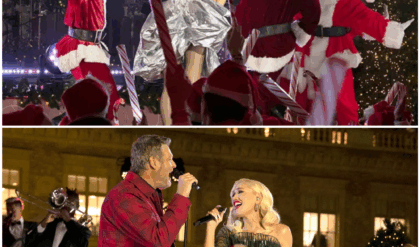In the quaint, fog-shrouded lanes of 1950s Cotswolds, where church bells toll against the backdrop of rolling hills and hidden sins, Father Brown has long been the unassuming guardian of truth. The BBC’s enduring cozy crime drama, inspired by G.K. Chesterton’s timeless short stories, has captivated audiences for over a decade with its blend of gentle wit, moral introspection, and clever whodunits. Now, with filming officially wrapped on Series 13, the sleuthing priest is poised to return, promising a season laced with shocking twists, chilling secrets, and an overarching mystery so profound it could upend the very foundations of Kembleford. Mark Williams reprises his iconic role as the bicycle-riding, umbrella-wielding Father Brown, joined by fan-favorites Tom Chambers, Claudie Blakley, Ruby-May Martinwood, and John Burton. Yet, amid the excitement, the BBC guards one explosive storyline close to its chest—a revelation that whispers of betrayal, institutional upheaval, and the fragility of faith itself.
Since its debut in 2013, Father Brown has evolved from a daytime slot curiosity into a global phenomenon, amassing over 120 episodes and spawning spin-offs like Sister Boniface Mysteries. Set in the fictional village of Kembleford, the series follows the Roman Catholic priest who uses his keen insight into human nature—honed by years in the confessional—to solve crimes that baffle the local constabulary. Williams’ portrayal infuses the character with a quiet charisma: bespectacled, soft-spoken, yet razor-sharp, Father Brown embodies Chesterton’s vision of a detective who sees the soul behind the sin. The show’s charm lies in its period authenticity—vintage cars rumbling down cobbled streets, tea rooms buzzing with gossip, and a community where everyone knows everyone’s business, or so it seems. Over the seasons, it has tackled themes from post-war trauma to social inequalities, all wrapped in standalone mysteries that often end with a redemptive twist.
Series 12, which aired in early 2025, left fans on a high note with the joyous wedding of Chief Inspector Sullivan (Tom Chambers) and Isabel Devine (Claudie Blakley). The finale’s celebratory air masked underlying tensions, setting the stage for what promises to be a bolder, more serialized narrative in Series 13. For the first time, the show introduces a stronger through-line, weaving episodic puzzles into a larger tapestry of intrigue. This evolution, as hinted by cast members, reflects the producers’ willingness to innovate while staying true to the cozy core. Ruby-May Martinwood, who plays the spirited Brenda Palmer, has spoken of the shift toward interconnected storylines, allowing deeper character development amid the crime-solving.
At the center of it all is Father Brown himself, drawn into a cat-and-mouse game that tests his vows like never before. Teasers suggest he becomes entangled with the enigmatic Father Lazarus, a imprisoned figure whose machinations reach beyond bars, pulling strings in Kembleford’s underbelly. Meanwhile, the arrival of Bishop-Elect Canon Fox introduces a formidable adversary, one whose plans to shutter St. Mary’s Church threaten the heart of the community. This looming closure isn’t just bureaucratic; it’s a seismic shift that could dismantle the parish Father Brown holds dear, forcing him to confront corruption within the church hierarchy. Whispers of hidden alliances, forged documents, and long-buried scandals add layers of suspense, with the priest navigating a web where faith and deception intertwine. The BBC has been coy about specifics, fueling speculation that this “explosive mystery” involves a personal betrayal or a revelation about Kembleford’s founding secrets—perhaps tied to wartime espionage or illicit fortunes that resurface with deadly consequences.
The returning cast brings continuity and fresh dynamics to these unfolding dramas. Mark Williams, whose affable demeanor belies a depth honed from roles in Harry Potter and Doctor Who, describes Series 13 as “darker and more introspective,” with Father Brown grappling with doubts that humanize him further. Tom Chambers’ Sullivan, now navigating married life, faces professional pressures that strain his partnership with the priest. Claudie Blakley’s Isabel steps into the spotlight as a member of the Policeman’s Wives Society, her enthusiasm for mysteries drawing her into the fray. Ruby-May Martinwood’s Brenda embarks on a journey of self-empowerment, stepping in as parish secretary and learning to drive under Sergeant Goodfellow’s (John Burton) guidance—a subplot that promises humor amid the tension. Burton’s Goodfellow, the ever-reliable sidekick, provides steadfast support, his comic timing a balm against the season’s shadows.
A surprise return elevates the ensemble: Sorcha Cusack reprises her role as the indomitable Mrs. McCarthy, the parish busybody whose absence in recent seasons left a void. Her comeback, teased in first-look images, kicks off the series with a bang, reuniting her with Isabel in a clash of secretaries that sparks both rivalry and camaraderie. Cusack’s portrayal, sharp-tongued yet deeply loyal, has been a fan favorite since the show’s inception, and her integration into the new arcs adds emotional weight. John Burton, in a behind-the-scenes nod, shared images of the cast looking dapper, hinting at formal events that mask underlying peril.
Guest stars inject star power and variety into the mix. Dame Maureen Lipman, known for her acerbic wit in Coronation Street, appears in a pivotal role, perhaps as a formidable dowager entangled in one of Father Brown’s cases. Sylvester McCoy, the Seventh Doctor from Doctor Who, brings eccentric flair, while Alexander Vlahos (Versailles) and Les Dennis (Extras) add intrigue. Other notables include Caroline Blakiston, George Rainsford, Lex Shrapnel, and Kieran Hodgson, each poised to deliver memorable turns in episodes that span from seaside escapades to prison visits. The series’ tradition of eclectic mysteries continues: expect puzzles involving alchemists’ secrets, treasure hunts gone awry, and murders disguised as accidents, all solved with Father Brown’s signature blend of logic and compassion.
Production on Series 13 wrapped in August 2025, with filming spanning picturesque Worcestershire locations that double as Kembleford. Highlights include Chastleton House for grand estates, Berkeley Castle for gothic atmospheres, and seaside shoots in Devon for a change of scenery. Mark Williams shared behind-the-scenes glimpses, praising the “fab locations” that enhance the show’s visual poetry—sun-dappled orchards, misty graveyards, and bustling village fetes. The soundtrack, composed by Debbie Wiseman, was recorded at AIR Studios, with sessions capturing the orchestral swells that underscore the drama’s emotional beats. Executive producer Neil Irvine emphasized the balance of “cozy comfort with edge-of-your-seat suspense,” crediting the writers for crafting arcs that resonate in today’s uncertain world.
Fan anticipation is palpable, with social media abuzz over first-look images and teasers. Unofficial accounts and dedicated forums dissect every clue, from Hercules the car’s appearances to subtle wardrobe changes signaling character growth. The show’s international appeal—airing on BritBox in the US and networks worldwide—stems from its escapist charm, offering a respite from gritty procedurals. Yet, Series 13’s darker tone, with its serialized elements, positions it to attract new viewers while rewarding loyal ones. Early buzz suggests episodes that “leave fans gasping,” with twists that challenge assumptions about allies and enemies.
As Father Brown pedals into its thirteenth outing, it reaffirms why this unassuming priest endures: in a world of moral ambiguity, his pursuit of truth offers hope. With premiere slated for January 2026 on BBC One and iPlayer, followed by BritBox internationally, the wait feels tantalizing. Will Father Brown save St. Mary’s? What shadows does Father Lazarus cast? And how will Kembleford’s secrets reshape its inhabitants? The answers lie in the confessional—or perhaps in the clues hidden in plain sight. One thing’s certain: this season’s mysteries won’t just be solved; they’ll transform the village forever.
The series’ longevity speaks to its timeless formula: clever plots rooted in human frailty, delivered with warmth and whimsy. From the Hammer of God to modern adaptations like poisoned pies at bake-offs, Father Brown honors Chesterton’s legacy while evolving. Series 13 builds on this, introducing serialized stakes that heighten emotional investment. Brenda’s driving lessons, for instance, symbolize her growth from sidekick to independent force, mirroring broader themes of empowerment in a post-war era.
Behind the camera, the team’s dedication shines. Directors like Ian Barber craft visuals that evoke nostalgia—soft-focus landscapes contrasting sharp interrogations. Writers, including Tahsin Guner, infuse scripts with Chesterton’s philosophical undertones, questioning justice and redemption. The production’s eco-conscious approach, using local crews and sustainable sets, aligns with the show’s gentle ethos.
As global fans saddle up for the ride, Father Brown Series 13 stands as a beacon of intelligent entertainment. In Kembleford, where secrets simmer beneath the surface, one priest’s curiosity could ignite change. Tune in, and prepare to be confounded, comforted, and utterly captivated.





